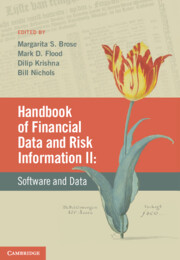Book contents
- Frontmatter
- Contents
- List of contributors
- Preface
- VOLUME II: SOFTWARE AND DATA
- PART IV DATA OPERATIONS IN FINANCIAL INSTITUTIONS
- PART V DATA MANAGEMENT TECHNOLOGIES
- 19 Financial data interchange standards
- 20 Data storage and processing
- 21 The extracting, transforming and transmitting of data
- 22 The visual analysis of financial data
- 23 Metadata management
- 24 Data security and privacy
- PART VI IMPLEMENTATION OF DATA AND ANALYTICS PROGRAMS
- Index – Volume II
- References
20 - Data storage and processing
from PART V - DATA MANAGEMENT TECHNOLOGIES
- Frontmatter
- Contents
- List of contributors
- Preface
- VOLUME II: SOFTWARE AND DATA
- PART IV DATA OPERATIONS IN FINANCIAL INSTITUTIONS
- PART V DATA MANAGEMENT TECHNOLOGIES
- 19 Financial data interchange standards
- 20 Data storage and processing
- 21 The extracting, transforming and transmitting of data
- 22 The visual analysis of financial data
- 23 Metadata management
- 24 Data security and privacy
- PART VI IMPLEMENTATION OF DATA AND ANALYTICS PROGRAMS
- Index – Volume II
- References
Summary
Introduction
Risk management depends heavily on analytics to generate information for decision making. It is no surprise, therefore, that computing has played a major role in risk management from the very beginning. In the past, risk measurement and reporting systems have largely been segregated by risk type – with separate systems for measuring credit, market and liquidity risk – though in some cases integrated market and credit engines have been developed. This approach is appealing because the systems are usually easier to implement when separate. It was also workable in an earlier age when it was tolerable for risk to be managed in silos. Recent developments have changed this dynamic significantly – not only do risk management systems need to integrate measurements across risk types due to needs like stress testing, but they also need to more readily integrate with transaction and finance systems to enable better Risk-Based Pricing (RBP) and Risk-Adjusted Performance Management (RAPM).
One unintended but favorable side-effect of segregated systems was that each computer system was not overly burdened by data processing requirements. The need for more integration has therefore posed a new and significant challenge to data processing technologies. Fortunately, we are in a period of tremendous innovation in data processing – data storage and processing technology have progressed to a point where these advanced needs are becoming eminently feasible. This chapter will first review the information needs of risk management, followed by a broad overview of data processing technology.
- Type
- Chapter
- Information
- Handbook of Financial Data and Risk Information IISoftware and Data, pp. 219 - 250Publisher: Cambridge University PressPrint publication year: 2014



